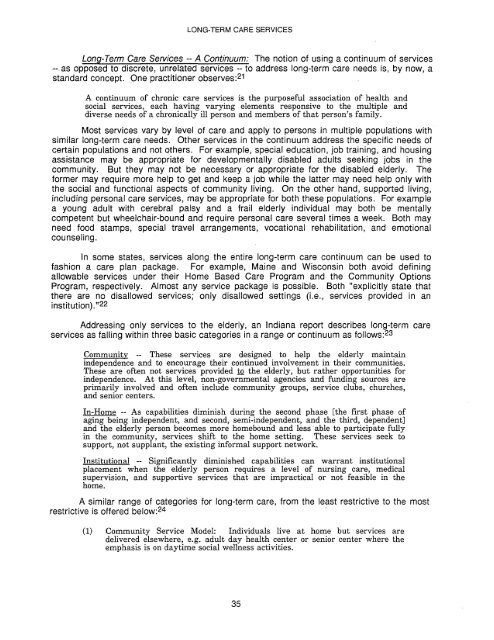long-term care - Legislative Reference Bureau
long-term care - Legislative Reference Bureau
long-term care - Legislative Reference Bureau
You also want an ePaper? Increase the reach of your titles
YUMPU automatically turns print PDFs into web optimized ePapers that Google loves.
LONG·TERM CARE SERVICES<br />
Long-Term Care Services -- A Continuum: The notion of using a continuum of services<br />
-- as opposed to discrete, unrelated services -- to address <strong>long</strong>-<strong>term</strong> <strong>care</strong> needs is, by now, a<br />
standard concept. One practitioner observes: 21<br />
A continuum of chronic <strong>care</strong> services is the purposeful association of health and<br />
social services, each having varying elements responsive to the multiple and<br />
diverse needs of a chronically ill person and members of that person's family.<br />
Most services vary by level of <strong>care</strong> and apply to persons in multiple populations with<br />
similar <strong>long</strong>-<strong>term</strong> <strong>care</strong> needs. Other services in the continuum address the specific needs of<br />
certain populations and not others. For example, special education, job training, and housing<br />
assistance may be appropriate for developmentally disabled adults seeking jobs in the<br />
community. But they may not be necessary or appropriate for the disabled elderly. The<br />
former may require more help to get and keep a job while the latter may need help only with<br />
the social and functional aspects of community living. On the other hand, supported living,<br />
including personal <strong>care</strong> services, may be appropriate for both these populations. For example<br />
a young adult with cerebral palsy and a frail elderly individual may both be mentally<br />
competent but wheelchair-bound and require personal <strong>care</strong> several times a week. Both may<br />
need food stamps, special travel arrangements, vocational rehabilitation, and emotional<br />
counseling.<br />
In some states, services a<strong>long</strong> the entire <strong>long</strong>-<strong>term</strong> <strong>care</strong> continuum can be used to<br />
fashion a <strong>care</strong> plan package. For example, Maine and Wisconsin both avoid defining<br />
allowable services under their Home Based Care Program and the Community Options<br />
Program, respectively. Almost any service package is possible. Both "explicitly state that<br />
there are no disallowed services; only disallowed settings (Le., services provided in an<br />
institution). "22<br />
Addressing only services to the elderly, an Indiana report describes <strong>long</strong>-<strong>term</strong> <strong>care</strong><br />
services as falling within three basic categories in a range or continuum as follows: 23<br />
Community -- These services are designed to help the elderly maintain<br />
independence and to encourage their continued involvement in their communities.<br />
These are often not services provided to the elderly, but rather opportunities for<br />
independence. At this level, non-governmental agencies and funding sources are<br />
primarily involved and often include community groups, service clubs, churches,<br />
and senior centers.<br />
In-Home -- As capabilities diminish during the second phase [the first phase of<br />
aging being independent, and second, semi-independent, and the third, dependent]<br />
and the elderly person becomes more homebound and less able to participate fully<br />
in the community, services shift to the home setting. These services seek to<br />
support, not supplant, the existing informal support network.<br />
Institutional -- Significantly diminished capabilities can warrant institutional<br />
placement when the elderly person requires a level of nursing <strong>care</strong>, medical<br />
supervision, and supportive services that are impractical or not feasible in the<br />
home.<br />
A similar range of categories for <strong>long</strong>-<strong>term</strong> <strong>care</strong>, from the least restrictive to the most<br />
restrictive is offered below: 24<br />
(1) Community Service Model: Individuals live at home but services are<br />
delivered elsewhere, e.g. adult day health center or senior center where the<br />
emphasis is on daytime social wellness activities.<br />
35
















